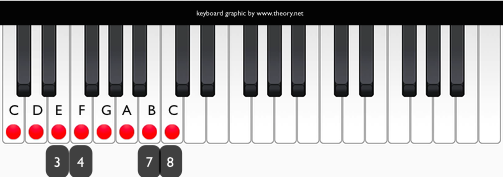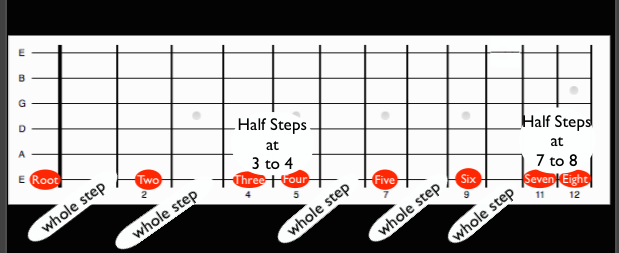Music Theory Second Floor
Ok so you have had a look around the site. Either you already have some music theory knowledge or you’ve gained enough from the videos and pages necessary to reach our second floor. So to double check, we can now assume that you understand the terms:
Pitch and pitch direction, half steps, whole steps, sharp, flat and natural accidentals, natural half steps as well a few other related terms and concepts as a basic grounding in your study of music theory.
If anything here does not compute go back and look over the earlier material some more. Perhaps go back to things you may have decided to skip altogether and fill in any gaps. Or, if you are a visual learner and you feel everything is up to date then skip to the Major Scale Part One Video .
If you feel ready then it is time to move on to the next bit.
The Continuation of the Meat and Potatoes of Music Theory
“The” “Major” Scale is the next item on our scheme of work list. Just to clarify, the scale we are discussing is the old Do Re Mi scale. You know…Julie Andrews? …Sound of Music? No? Ok don’t worry we will get to that. Anyway…I put quotes on the words “the” and “major” for a reason. The word “the” implies that there is only one major scale. That just isn’t so. Likewise that implies that the word “major” is the name of that one specific scale. This is also not so.
Let’s keep it simple and say that “The Major” scale is a nickname for the scale we use as the mother ship of all scales. Its other name is the Ionian scale. If that makes sense then let’s go back to just calling it the major scale from now on.
The Major Scale
In western music theory the (Ionian) Major Scale is
The Grand Poobah...
The Big Kahuna...
The Tribal Chief...
The Mother Ship of ALL scales that we use to name and compare pretty much everything else to! Yep it's pretty important... let's have a look then.
We use the major scale as a reference datum in order to label patterns and terms in western music theory.

But what is this major/Ionian scale? Well people think of it and say it lots of ways. The best way for me is to just think of it and say it as the following:
The Major Scale is ANY scale that has half steps at 3 to 4 and at 7 to 8. That’s it.
The only other assumption is that all the rest of the steps are whole steps, the next largest thing bigger than half steps. You will remember that half steps are the smallest discriminate division of pitch in the twelve tone system, right? If it sounds clearer to you, you could say and think:
The Major Scale is ANY scale that is all whole steps except for half steps at 3 to 4 and at 7 to 8.
If you sing or play this pattern you will hear the familiar Do Re Mi Fa Sol sound of the “mother ship” major scale.... Doe a deer.. a female deer... Ray a drop of golden sun... no? ...don't worry we'll get back to that...

Ok I hope we have made a good start here. Keep your eye (and bookmark) here on my little site as a video tutorial or two are on the way to give some more detail and demonstration. In the mean time have a look at this perspective of a major scale lesson courtesy of www.musictheory.net. (the underlying fretboard graphic and keyboard above are also by permission of musictheory.net many thanks to them!)
Learn the Major Scale
Here is a crash course in four plus minutes on the major scale concept. Enjoy yourself, happy playing....
Use Your Ears Alone
Ok... get yourself a cup of tea or coffee or whatever and settle down in a comfortable place of peace and quiet. Have a session doing this customised ear training exercise (again courtesy of music theory.net). Try to assign tunes for each of the major or perfect intervals. For instance a Perfect Fourth is the first two notes of We Wish You a Merry Christmas. Happy Birthday starts with a major second. Get the idea? "Aural Mnemonics" could be a label for this concept.... maybe?
CLICK HERE FOR THE SIMPLE MAJOR INTERVALS TRAINER
Final Tips and Hints
Try to keep it simple. Remember that things get labelled according to how they work. For example, the "Root" of a scale is the letter name of the note you start on. After you exhausted the seven letters of the alphabet we use in music theory you reach the "Root" again but it may be referred to as the "Octave" or the "root" or simply even "the eighth" or "the one"! Don't let minor changes of perspective get confusing. Think of them as being more and more accurate ways of labelling things. If you are counting pitches (notes or tones) then count pitches. If you are counting steps whether, they be half or whole, then count steps. Don't confuse pitch number one and two with step number one and two.
Be aware of the language. Just like in any language words can describe, measure, convey position or purpose. For example:
Tone can mean:
- the sound characteristic or timbre "a warm tone or bright tone"
- the distance between two sounds i.e. whole tone or half tone
- the exact place in a scale such as the "third tone"
- the function of a note like a "chord tone or a non-chord tone"
To go to the Major Scale Part Two click here for next page
Home>Top of Page>Back to Music Theory First Floor>Go to Second Floor Page Two
If you are local to the United Kingdom West Midlands Coventry Kenilworth Leamington Warwick Rugby Stoneleigh CV8 Post Code area and are interested in tuition feel free to arrange a “First session Free” Guitar or Theory Lesson. Perhaps you just want to *chat over a cuppa about the options for your children’s music education.
Playable Guitar
Rural Innovation Centre Unit 32 Avenue H
Stonleigh Park CV8 2LG +44 2476 998 500
International? Please contact me about Skype lessons. Se habla español – pues bueno un pocito!
click here to see other ways to support this site
Got suggestions or questions?
Want to try a free Skype or Zoom lesson?
Got a testimonial? click here
Click the link to the contact form above or write to me at the address shown and I will get back to you as quick as I can !
Happy playing!


